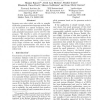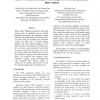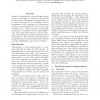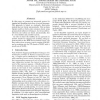COLING
2000
14 years 27 days ago
2000
Systems now exist which are able to con:pile unification gralmnars into language models that can be included in a speech recognizer, but it is so far unclear whether non-trivial l...
COLING
2000
14 years 27 days ago
2000
We propose a treatment of `extraposition' which allows items to be assimilated directly even when they appear far from their canonical positions. This treatment supports anal...
COLING
2000
14 years 27 days ago
2000
While large POS(part-of-speech) annotated corpora play an important role in natural language processing, the annotated corpus requires very high accuracy and consistency. To build...
COLING
2000
14 years 27 days ago
2000
Sumo is a formalism for universal segmentation of text. Its purpose is to provide a framework for the creation of segmentation applications. It is called universal as the formalis...
COLING
2000
14 years 27 days ago
2000
This paper presents the use of probabilistic class-based lexica for disambiguation in targetword selection. Our method employs minimal but precise contextual information for disam...
COLING
2000
14 years 27 days ago
2000
A method is de.scribed by which a rhetoricalstructure tree can be realized by a text structure made up of sections, paragraphs, sentences, vertical lists, mid other textual patter...
COLING
2000
14 years 27 days ago
2000
Data-Oriented Translation (DOT), which is based on Data-Oriented Parsing (DOP), comprises an experience-based approach to translation, where new translations are derived with refe...
COLING
2000
14 years 27 days ago
2000
Most of the studies in the framework of Lambek calculus have considered the parsing process and ignored the generation process. This paper wants to rely on the close link between ...
COLING
2000
14 years 27 days ago
2000
In this paper we present an integrated system for tagging and chunking texts from a certain language. The approach is based on stochastic finite-state models that are learnt autom...
COLING
2000
14 years 27 days ago
2000
We present a formal semantics for an objectoriented formalism which allows for the representation of plural objects (such as `Three N', `Most of the N', `Some N',.....




